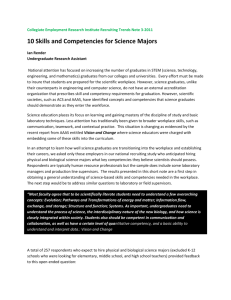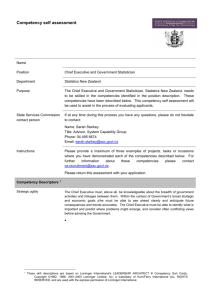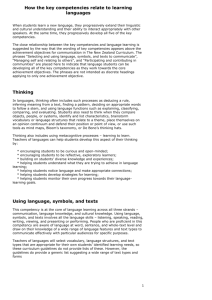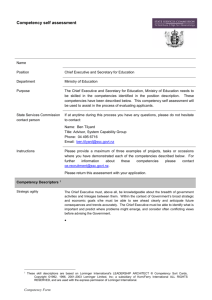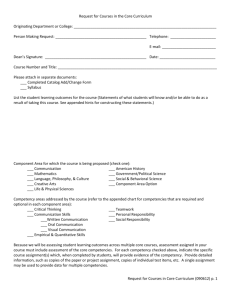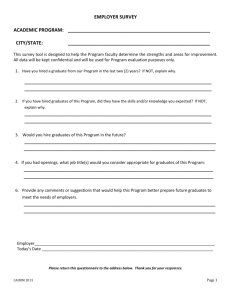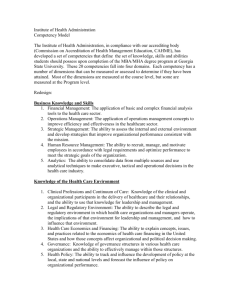Competency based professional accounting certification in
advertisement
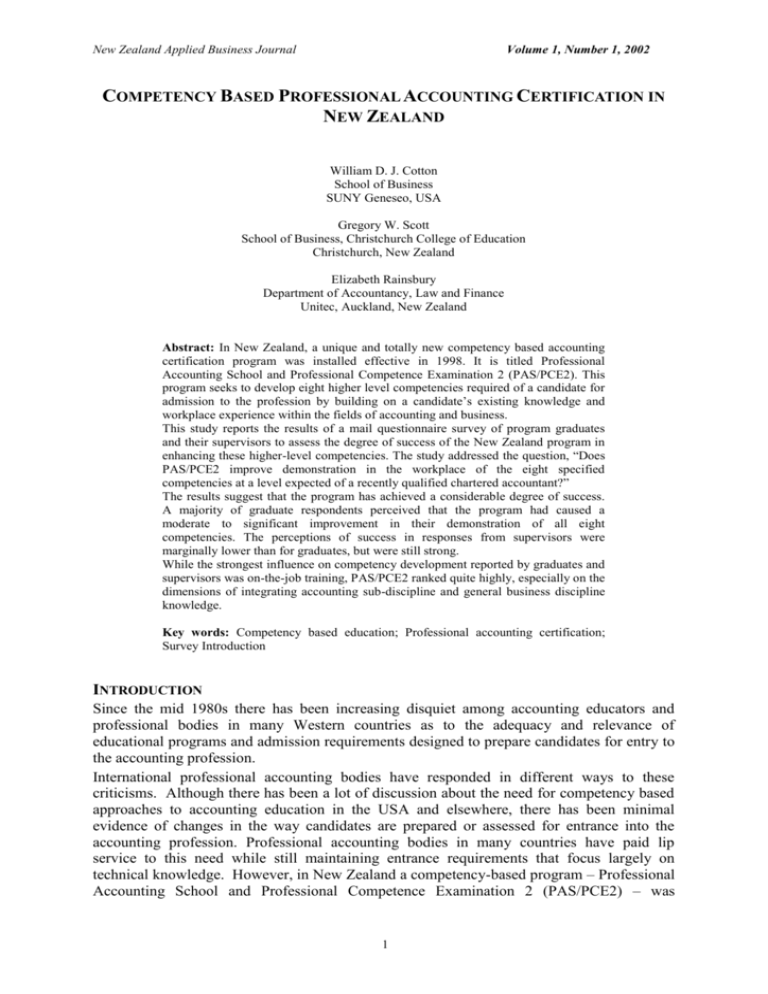
New Zealand Applied Business Journal Volume 1, Number 1, 2002 COMPETENCY BASED PROFESSIONAL ACCOUNTING CERTIFICATION IN NEW ZEALAND William D. J. Cotton School of Business SUNY Geneseo, USA Gregory W. Scott School of Business, Christchurch College of Education Christchurch, New Zealand Elizabeth Rainsbury Department of Accountancy, Law and Finance Unitec, Auckland, New Zealand Abstract: In New Zealand, a unique and totally new competency based accounting certification program was installed effective in 1998. It is titled Professional Accounting School and Professional Competence Examination 2 (PAS/PCE2). This program seeks to develop eight higher level competencies required of a candidate for admission to the profession by building on a candidate’s existing knowledge and workplace experience within the fields of accounting and business. This study reports the results of a mail questionnaire survey of program graduates and their supervisors to assess the degree of success of the New Zealand program in enhancing these higher-level competencies. The study addressed the question, “Does PAS/PCE2 improve demonstration in the workplace of the eight specified competencies at a level expected of a recently qualified chartered accountant?” The results suggest that the program has achieved a considerable degree of success. A majority of graduate respondents perceived that the program had caused a moderate to significant improvement in their demonstration of all eight competencies. The perceptions of success in responses from supervisors were marginally lower than for graduates, but were still strong. While the strongest influence on competency development reported by graduates and supervisors was on-the-job training, PAS/PCE2 ranked quite highly, especially on the dimensions of integrating accounting sub-discipline and general business discipline knowledge. Key words: Competency based education; Professional accounting certification; Survey Introduction INTRODUCTION Since the mid 1980s there has been increasing disquiet among accounting educators and professional bodies in many Western countries as to the adequacy and relevance of educational programs and admission requirements designed to prepare candidates for entry to the accounting profession. International professional accounting bodies have responded in different ways to these criticisms. Although there has been a lot of discussion about the need for competency based approaches to accounting education in the USA and elsewhere, there has been minimal evidence of changes in the way candidates are prepared or assessed for entrance into the accounting profession. Professional accounting bodies in many countries have paid lip service to this need while still maintaining entrance requirements that focus largely on technical knowledge. However, in New Zealand a competency-based program – Professional Accounting School and Professional Competence Examination 2 (PAS/PCE2) – was 1 Volume 1, Number 1, 2002 New Zealand Applied Business Journal introduced in 1998. The program seeks to develop eight competencies. There has been very little work done to evaluate the success or otherwise of the PAS/PCE2 model or of similar approaches. This study examines the results of a mail questionnaire of graduates and their supervisors for three years 1998-2000 to assess the degree of success of the New Zealand program in developing the eight competencies. The contribution of this study will be to provide evidence on perceptions of the success of the New Zealand competency based initiative. This should inform the future development of the program in New Zealand and the initiatives underway in other countries to install similar programs. INTERNATIONAL DEVELOPMENTS IN PRE-ENTRY ACCOUNTING EDUCATION United States Disquiet about pre-entry accounting education was first articulated in the United States in the Bedford Report (1986). It was observed that many accounting educators questioned university accounting teaching and learning processes on two counts: they believed the material taught and learned was inadequate and they questioned the effectiveness of traditional teaching and learning methods. They argued that many accounting graduates did not know how to communicate could not reason logically and had limited problem solving ability. Three years after the Bedford Report the then “Big 8” accounting firm published a White Paper (1989) on the topic that dealt with the attributes necessary for success in the accounting profession. The White Paper acknowledged the work of the Bedford Committee and used its conclusions as a basis for its own recommendations. Among the necessary knowledge and skills identified by the white paper were; communication skills, intellectual skills, interpersonal skills general knowledge, organisational and business knowledge, and accounting and auditing knowledge. In response to the call for change by both the Bedford Committee and the Big 8 White Paper, the American Accounting Association (AAA) entered into a memorandum of agreement with the firms on June 30 1989, and this provided for the creation of the Accounting Education Change Commission (AECC). The Commission’s role was outlined in their “Position Statement Number One” (1990). Their objective was to foster changes in the academic preparation of accountants consistent with the goals of improving their capabilities for successful professional careers in practice. Since 1990 the AECC has promulgated “Issue” and “Position” statements and provided significant grants to educators with the objective of fostering change from a procedural to a user emphasis and increased attention to communication skills. The activities of the AECC are generally believed to have commenced a change process in the US, which is still continuing to this day. Other developments in the US include pronouncements on the issue by: the Institute of Management Accountants (IMA), the Financial Executives Institute (FEI) (What Corporate America Wants in Entry-Level Accountants, 1994), the IMA alone (Counting More, Counting Less, 1999), and the American Institute of Certified Public Accountants (AICPA) Vision Project (1998). This latter project is multi-faceted and aimed at a comprehensive and integrated vision of the profession’s future in the US. Competencies have been grouped into three proficiency levels, (Basic, Intermediate and Advanced), and four areas of competency: Personal Competencies (e.g. professional attitude and demeanor, decision-making, communication), Functional Competencies (e.g. risk analysis, reporting and measurement), Broad-Based Competencies (e.g. resource management, marketing, client focus) and Leadership Competencies (e.g. facilitating, 2 New Zealand Applied Business Journal Volume 1, Number 1, 2002 teamwork and problem solving). The top five core competencies identified in this project were: communication and leadership skills, strategic and critical thinking skills, focus on the customer, client and market, and interpretation of converging information; and technological adeptness. The competency model is described as applicable for the “New Finance Professional” and is intended for use by: individual CPAs for career development, employers for identifying professional development needs, professional bodies in developing continuing professional education needs and academics in designing programs. The vision project continues to refine these competencies, including some initiatives with the AAA, and latest developments can be accessed from the AICPA web-site, www.aicpa.org. Other Countries Concurrent with these activities in the US, there have been a number of developments in other countries. Some of these developments have occurred under the banner of the International Federation of Accountants (IFAC). In their publication IEG-9 (1996) the IFAC concluded that a program of accounting education and experience must go beyond mere transfer of knowledge. They argued that learning should be defined as principles, standards, concepts, facts and procedures at a point in time. Beyond that, emphasis must be placed on a set of knowledge, skills and professional values broad enough to enable new entrants to the profession to adapt to change. The Education Committee of IFAC published a discussion paper (1998), which addressed competence-based approaches to the preparation of accountants. This paper discussed the challenge posed to member bodies by new approaches to the definition and assessment of competence and their application to the development of future professional accountants. This discussion paper concluded that competence-based approaches offer a systematic and effective way of ensuring that the expectations of employers and the public are met, however their development and implementation would require close cooperation between associations, higher education and employers. The paper concluded with a range of policy options for national associations in implementing a competence-based qualification system. More recently the IFAC has issued a more comprehensive discussion paper (2001), which updated the 1998 paper with the objective of offering general guidance to member bodies on how to implement competence-based approaches. It drew upon responses to the first paper and changes in the field of competence-based approaches since that time. Professional accounting bodies have not been silent on the issue, particularly those from the English-speaking world. This group meets on an ad hoc basis and is known collectively as “CAGE ”. This is an acronym for “Chartered Accountants Group Executives” from England and Wales, Scotland, Ireland, Canada, South Africa, Australia and New Zealand. In recent years, meetings of the group have been dominated by concerns about the need for more competency-based education for accountants, and jurisdictions in these countries have produced papers on the issue. In Canada a task force created in 1998 by the Certified General Accountants Association (CGA) identified 24 competencies required of accountants. Only seven of these pertained to functional accounting competencies, with the remainder relating to applied business/management skills, personal management skills and leadership skills. The Canadian Institute of Chartered Accountants (CICA) is changing their qualification process to ensure a broader range of competencies for a rapidly changing marketplace. The new competencies are described as the “Canadian CA Competency Map” These will be applied within tertiary institutions as well as professional accountancy programs. This new system was installed in the Western Canadian Provinces in 2001. The Institute of Chartered Accountants in England and Wales require the completion of a training contract undertaken within mentor organisations, which includes assessment while 3 Volume 1, Number 1, 2002 New Zealand Applied Business Journal completing work experience in communication skills, information technology, commercial awareness and professional ethics. In Australia a competency based program of professional education for admission to the Institute of Chartered Accountants of Australia (ICAA) was established in 2001. It includes three technical modules (Financial Reporting and Assurance, Taxation and Financial Reporting, Strategic Business Management), which are completed while gaining mentored work experience, plus a Final Integrative module. This final module is designed to assess in a variety of ways the knowledge, skills and values gained from the overall program using a case-study approach. All of these pronouncements, statements and studies have resulted in very little change in teaching and assessment in many countries. The only countries to have installed new competency based approaches to professional accounting certification are Australia (2001), Canada – Western Provinces (2001) and New Zealand (1998). New Zealand In the early 1990s the entry process for admission to membership of the Institute of Chartered Accountants of New Zealand (ICANZ) was based on studies at approved tertiary institutions and a final qualifying examination (FQE) administered by the ICANZ. This came under scrutiny from other international professional accounting bodies. There was a perception that these qualifications were not sufficiently rigorous for the demands of the modern profession. One consequence of this scrutiny was a decision by the Institute of Chartered Accountants of Australia (ICAA) to suspend reciprocity of qualifications until changes were made in New Zealand and were seen to be effective. Around the time this review was carried out, ICAA and ICANZ (then known as the New Zealand Society of Accountants) commissioned a research study (Birkett, 1993) to outline the competencies expected of an effective chartered accountant. This study recommended competency standards for six fields of practice, applicable to three types of work location, for six key accounting roles. The international review and the Birkett study triggered a separate ICANZ review of their membership structure. This resulted in the formation of a new three-tier membership structure effective January 1 1996: Accounting Technician (AT) For those who provide para-professional accounting services (middle-level and assistant accountants or office and administration managers). Associate Chartered Accountant (ACA) For those accountants who are not actively involved in providing core accounting services or do not require international recognition. Chartered Accountant (CA) For those who are actively involved in providing core accounting services or require international recognition of their status. Members seeking to offer their services to the public must be members of this group. The framework for admission to each of these categories is similar and comprises three basic components: academic study, practical experience under the supervision of an officially sanctioned ICANZ mentor and the development and assessment of professional competence. Candidates for admission to the CA designation require three year’s practical experience. In 1996 ICANZ established a wholly owned subsidiary to address this professional competence dimension. This organisation is a company named Advanced Business Education Limited (ABEL), and during 1997 considerable work went into the organisation of ABEL and into the development of its programs. The first professional competency programs were 4 New Zealand Applied Business Journal Volume 1, Number 1, 2002 delivered for the calendar year 1998. These professional competency programs consist of two stages. The first is called Professional Competence Examination 1 (PCE1) and is a prerequisite for admission to all three professional designations. The second encompasses the Professional Accounting School (PAS) and the Professional Competence Examination 2 (PCE2), and is required of all those seeking to become Chartered Accountants (CAs). The PCE1 program deals with the legislation and rules governing the structure of the accounting profession in New Zealand and overseas, ethics and ethical behavior, and selected current professional issues of a non-technical nature. The PAS/PCE2 program incorporates a competency-based approach to educating candidates for entry to the accounting profession and is the major focus of this research study. EDUCATING FOR AND MEASURING PROFESSIONAL COMPETENCY The field of competency education and measurement has been widely canvassed and researched in a variety of professional contexts, most notably in the education literature. For example some define competency in relation to characteristics possessed by an individual, which should result in an acceptable or superior job performance (Spencer and Spencer, 1993). Others take a behaviorist approach and view competency as any aspect of the inner person normally displayed as behaviours, which enable individuals to perform “competently” (Boam and Sparrow, 1992). Another view is that a competency-based assessment strategy should be aimed at assessing whether an individual has the capacity to exercise “intelligent skill knowledge” (Gonzci, 1993; Elliott, 1990). This means the capacity for individuals to discriminate, discern and apply a knowledge base, technical skills and appropriate attitudes to situations in which they find themselves. This approach suggests that assessment methods will do this best if they are as integrated and direct as possible and gathered from real life work situations or simulations of this. Of more interest are the competencies expected of the effective professional accountant. Many of these have been discussed in depth by the professional accounting bodies referred to earlier in this paper. It might be argued that to demonstrate “competence”, professional accountants require a broad range of skill areas in addition to the technical knowledge of accounting disciplines. Within this broad definition of competence, three views are possible (Brown, 2001). One view emphasizes the demonstration of satisfactory performance against sets of standards (functionalist approach). A second view (sometimes called the holistic approach (Birkett, 1993)) proposes that the accounting professional must also apply and adapt skills in a wide range of contexts in which they will be applied (Heaton, 1996; Gonzci, 1994). This view incorporates the necessity to possess skills required to exercise professional judgment (such as listening, inquiry) as well as technical knowledge. The third view (integrated), adopted by ABEL in developing PAS/PCE2, recognizes that professionals will have different ways of achieving desired outcomes and that what is required is for outcomes to be defined against which competence can be measured. These are both behavioral (communication/interpersonal skills) and cognitive (accounting and business knowledge, critical thinking, problem solving). A broad range of learner-centered teaching and assessment processes may then used to evaluate competency in the outcome areas defined. Although there has been a lot of discussion of the need for competency based approaches to accounting education in the USA and elsewhere, there has been little evidence of changes in the way candidates are prepared or assessed for entrance to the accounting profession. Professional accounting bodies in many countries have paid lip service to this need while still maintaining entrance requirements, which focus largely on technical knowledge. There has 5 Volume 1, Number 1, 2002 New Zealand Applied Business Journal also been very little work done to evaluate the success or otherwise of the PAS/PCE2 model or of similar approaches. This study will provide valuable evidence on perceptions of the success of the New Zealand competency based initiative. The conclusions of the study are derived from program graduates and workplace supervisors of program graduates for the three years 1998 - 2000. Structure of the PAS/PCE2 Competency-Based Program The PAS/PCE2 program is the focus of this research study. This is a competency-based program for educating and assessing potential entrants to the chartered accounting profession in New Zealand. Since it was the first competency-based program installed by a professional accountancy body anywhere in the world it has attracted considerable interest from other professional accounting bodies. Among the innovative features are self-study modules and hands-on workshops focussed not only on contemporary and strategic issues but also such cognitive and behavioral skills as good verbal and written communication, information synthesis, problem solving, negotiation and team management. The eight specific competencies addressed by the program are the ability for candidates to: Identify and solve business problems in the unstructured business environment, Communicate in writing and verbally, Demonstrate an ethical awareness, Research, analyse and synthesise Information, Work in a team and where necessary take a leadership role, Organize themselves, peers and subordinates to achieve goals within deadlines, Integrate accounting sub-discipline knowledge to arrive at an informed accounting judgement in a range of business contexts, and Understand and work with a range of other business disciplines within an organisational context. These competencies provide the underpinning for all the study plans, workshops, assessments and examination methods used in the ABEL program. The structure of this program for the three years 1998 – 2000 is diagrammed in Appendix I. From this it can be seen that the PAS segment consisted of three modules; Business Environment, Compliance and Financial Management, and that each module comprised self-study material and two workshops. Each workshop consisted of twenty-five candidates split into teams with five people in each team. A considerable amount of the activity in the workshops was conducted in teams and the team members were encouraged to communicate with each other between workshops as they worked on their self-study material. The final PCE2 examination consisted of two four-hour open book case study examinations.1 Among the strong features of each of the three modules were the linkages with the competencies being addressed. Each study plan segment outlined the nature of the competencies addressed by that segment and each workshop activity was related to specific competencies. The latter was achieved through the use of a “Development and Assessment Matrix” for each workshop in each module. This was complemented by an over-arching “Competencies Matrix”, which indicated how the study plans, the informal group work, the workshops, the assessment methods, and the final examinations, contributed to the various competencies. Further details about the PAS/PCE2 programme are available from the ICANZ web site: http://www.icanz.co.nz. 1 In 2001 the PAS program was modified by condensing the first module and adding a final capstone module on Business Strategy. In addition PCE2 was modified by replacing the two four-hour case study final exams with one six-hour case study final exam. 6 New Zealand Applied Business Journal Volume 1, Number 1, 2002 Technical accounting education is not ignored in the New Zealand model. Underlying the PAS/PCE2 programme is a required level of technical knowledge gained from a four-year undergraduate accounting degree accredited by ICANZ. These degree programs are reviewed regularly by the Admissions Department of ICANZ. It is clear that this program is innovative in character and is a significant departure from the qualification and assessment models employed by many professional accounting bodies. As such it is attracting interest and scrutiny from overseas bodies. A major aim of this research project is to assess the success of the PAS/PCE2 program in meeting its stated aims. THE RESEARCH QUESTION Given the issues related the difficulty of identifying a control group and the existence of intervening variables, the research question needed to address perceptions rather than hard measurements. These perceptions needed to relate to the extent to which the eight PAS/PCE2 competencies were demonstrated in the workplace after graduation from the program. Thus the final form of the question to be researched was: Does PAS/PCE2 improve demonstration in the workplace of the eight specified competencies at a level expected of a recently qualified chartered accountant? THE STUDY The study consisted of a mail questionnaire survey of 1998, 1999 and 2000 graduates from the program and their supervisors in the workplace. This method of research was chosen after considering and rejecting such other methodologies as focus groups, individual interviews and observation of graduates in the workplace. All three of these possible alternatives would have been expensive and suffered from lack of generalisability. A draft of the graduate questionnaire was tested on a focus group of seven graduates drawn from a spectrum of firms, age groups, gender and graduation dates. The supervisor questionnaire was similarly tested with representatives from a variety of employing organisations. This provided valuable feedback on the questionnaire design and wording. The final version of the instrument2 was divided into four sections: personal profile, work profile, appraisal of competencies and key influences on competency development. In the appraisal of competencies section, graduates were asked their opinion of the effectiveness of PAS/PCE2 in developing their ability to demonstrate particular competencies in the workplace. In the key influence on competency development section they were required to rank PAS/PCE2 against other forms of competency development. Supervisors were asked a similar set of questions and there was also space for open-ended narrative answers in both questionnaires. It was desired to survey both program graduates and their supervisors. Accessing graduates from the program did not prove to be a problem since their names were taken from the ICANZ database, although up-to-date addresses were not always available, especially for graduates who were working overseas. Defining and accessing a database for workplace supervisors of program graduates proved difficult. The views of supervisors of graduates were sought, but it was difficult to identify who those people would be, especially in large firms. Initially a two-pronged approach to accessing supervisors was adopted. First, the HR departments of the Big 5 and Audit New Zealand (the government auditor) distributed the questionnaire to supervisors of graduates. Second, graduates employed at other organisations were sent a questionnaire to give to their supervisor. 2 A copy of each questionnaire is available from the authors on request. 7 Volume 1, Number 1, 2002 New Zealand Applied Business Journal This second approach resulted in relatively few responses and was supplemented by sending the supervisor’s questionnaire to all ICANZ candidate mentors. The official mentors were chosen because they would be in regular contact with their candidates, overseeing their work, checking their logbook and discussing their progress. The mailing to mentors generated a satisfactory response. To summarise, the graduate population consisted of 1129 individuals, 147 of whom were initially identified as being domiciled overseas. The supervisor population consisted of 140 supervisors in Big 5 firms and Audit New Zealand, 753 candidate mentors spread across a variety of firms, and an unknown number of supervisors to whom questionnaires were given by graduates. THE RESULTS Usable responses were received from 390 graduates and 322 supervisors. These may be summarised as follows: Graduates Population Responses % Response New Zealand Domiciled 982 335 34.1% Overseas Domiciled 147 55 37.4% Total 1129 390 34.5% Supervisors Big 5 + Audit NZ 140 80 57.1% Candidate Mentors 753 197 26.2% Sub-Total 893 277 31.0% Graduate Hand-out NA 45 NA Total 322 Although the response rate of over 30% was encouraging, non-response bias is always likely in survey research of the type reported in this paper. Non-response bias tests were carried out in respect of the responses from graduates and supervisors. The first test suggested by Moore and Reichert (1983) checks for differences between the characteristics of respondents and the characteristics of the population at large. There were no population demographics available for supervisors, but for graduates data for the year of graduation and for gender were available. In respect of graduates there was no statistically significant difference observed between the responses and the population characteristics in respect of gender, but there was a difference for the year of graduation. There were relatively more responses from year 2000 graduates. This suggests that the graduate responses reported in this paper tend to reflect less the views of 1998 and 1999 graduates and more the views of those from the year 2000. Second an analysis was performed of early and late responses, as suggested by Wallace and Mellor (1988). The rationale for this is that the late respondents are more likely to reflect the characteristics of the non-respondents. In respect of graduates and supervisors statistical tests were performed on the responses to Part 3 of the questionnaire, which related to the eight competencies. Statistically significant differences were observed at the 5% level in respect of four of the eight competencies when comparing responses from the first 25% and the last 25% of graduates.3 However a similar test for supervisor responses revealed a statistically 3 The authors take some comfort from the fact that higher ratings were assigned to these four competencies by the last 25% of graduates, suggesting a positive rather than a negative bias. 8 New Zealand Applied Business Journal Volume 1, Number 1, 2002 significant difference for only one competency. It may be concluded that the existence of some non-response bias has to be recognised, in spite of the relatively high response rate. The profile of the respondents is summarised in Table 1. Graduates Male Female No response Total Supervisors n 203 187 % 52.1 47.9 390 100% n 238 83 1 322 Graduates % 73.9 25.8 0.3 100% Supervisors Age 20-24 25-29 30-39 More than 39 No response Total n 27 284 60 19 % 6.9 72.8 15.4 4.9 390 100 n 0 26 150 144 2 322 Core Business Big 5 CA CA other Corporate Public Service Other No response Total n 132 79 140 35 2 2 390 % 34.0 20.4 36.1 9.0 0.5 0.0 100 n 126 111 36 45 3 1 322 Graduates % 0 8.1 46.6 44.7 0.6 100 Supervisors Year Graduates Completed PAS/PCE2 1988 1999 2000 Total % 39.1 34.5 11.2 14.0 0.9 0.3 100 n % 50 141 194 385 13.0 36.6 50.4 100 Table 1: Graduate and Supervisor Survey Profile of Respondents The gender of graduate respondents is roughly even, whereas the majority (74%) of supervisor respondents are male. This most likely reflects the “glass ceiling” effect, which has been evident of a number of studies of gender differences in the workplace. As might be expected, the mean age of the graduates is significantly less than that of supervisors, and this may explain to some extent the apparent “glass ceiling” effect. Of more concern is the fact that the proportion of responses from graduates in the corporate sector is significantly greater than the proportion from supervisors in that sector. This will be commented upon further when evaluating the perceptions of these groups. Appraisal of Competencies Section three of the survey instrument asked graduates and supervisors the extent to which PAS/PCE2 had improved the ability to demonstrate the eight competencies in the workplace at a level expected of a recently qualified chartered accountant. Respondents were required to 9 Volume 1, Number 1, 2002 New Zealand Applied Business Journal answer using a five-point scale where 1 = significant improvement, 3 = moderate improvement and 5 = no improvement. The results are summarised in Table 2. To what extent has PAS/PCE2 improved your ability to demonstrate the specified competency in the workplace at a level expected of a recently qualified chartered accountant? 1= significant improvement, 5 = no improvement Competencies Mean Graduate 2.82 Mean Supervisor 3.02 Mean diff -0.20 t statistic p value 3.06 0.002* Communicate in writing and verbally 2.90 3.27 -0.37 2.024 0.000** Demonstrate ethical behaviour 3.24 2.96 0.28 2.132 0.0333* Research, analyse and synthesise information 2.93 2.94 -0.01 0.125 0.900 Work in a team and where necessary take a leadership role 2.69 3.11 -0.42 5.347 0.000** Organise yourself, peers and subordinates to achieve goals within deadlines 2.89 3.20 -0.31 4.025 0.000** Integrate knowledge in accounting sub-disciplines to arrive at informed judgements in a range of business contexts Understand and work with a range of other business disciplines within and organisational context 2.64 2.92 -0.28 3.811 0.000** 2.78 3.16 -0.38 5.103 0.000** Identify and solve business problems in the unstructured business environment Table 2: Competency Appraisal: Graduates versus Supervisors * = statistically significant at 5% level ** = statistically significant at 1% level From this it was observed that only in the case of the ethical behavior competency was the mean response from graduates worse than 3. This suggests a good level of satisfaction among graduates regarding the competencies that the programme addresses. Further analysis, not reported in a formal table, showed the following percentages of graduates and supervisors perceiving a moderate to significant improvement in their competencies: 10 New Zealand Applied Business Journal Volume 1, Number 1, 2002 Competency Moderate - Significant Improvement Graduates Supervisors 79% 74% 74% 62% 62% 74% 73% 76% 77% 67% 71% 63% 82% 76% 76% 66% Problem solving Communication Ethical behavior Research, analyse and synthesise Teamwork and leadership Organisation and time management Integrate accounting sub-disciplines Integrate other business disciplines Perusal of Table 2 shows that graduates perceived that PAS/PCE2 was most beneficial in developing the ability to integrate accounting sub-discipline knowledge, followed by teamwork and leadership. Also scoring well were integrating other business disciplines and problem solving in the unstructured business environment. These are very encouraging results and tend to support a conclusion that the ABEL program has been successful in achieving its stated aims, at least from the viewpoint of its graduates. The mean scores from supervisor respondents were also encouraging. However inspection of Table 2 reveals that although quite high, these scores were statistically significantly less favorable than those from graduates in respect of six of the eight competency dimensions. In one case they were significantly better (demonstrate ethical behavior) and in another case they were virtually the same (research, analyse and synthesise information). Nevertheless the mean scores from supervisors still reflected an overall favorable impression of the programme, due largely to clustering around the “moderate improvement” level (3 on the 5point scale). DIFFERENCES IN APPRAISALS Other than tests of the differences in perceptions between graduates and supervisors, statistical tests were conducted for other potential differences. Table 3 reveals no statistically significant differences between perceptions of graduates working in CA firms versus those working in a non-CA firm environment. Likewise Table 4 shows that, other than in the perceived ability to research, analyse and synthesise information, there were no significant differences among graduates working in Big 5 versus Non-Big 5 CA firms. Graduates from Non-Big 5 CA firms found greater improvement in this competency. Tests were conducted also for differences among graduates by gender and by age and no statistically significant differences were found.4 Tests for differences among responses from supervisors from different backgrounds were carried out. The only instance where significant differences were found was in perceptions of supervisors from CA versus Non CA firms. Perusal of Table 5 shows that supervisors from a Non CA firm environment believed that PAS/PCE2 had improved two of the competencies to a greater degree. The two competencies were the ability to research, analyse and synthesise information, and to organize and achieve goals within deadlines. These results must be viewed with caution since the proportion of responding Non CA firm supervisors is significantly less than the proportion of graduates responding from Non CA firms. 4 In some cases the total sample did not equal 390 because some respondents did not evaluate each competency. Non-parametric tests were conducted since the Jarque Bera statistic indicated that not all distributions were normal. Non of the Mann-Whitney non-parametric tests were significant. 11 Volume 1, Number 1, 2002 New Zealand Applied Business Journal The fact that very few significant differences were found in responses from graduates and supervisors working in different types of firms is notable. This suggests that the programme is equally beneficial to graduates in Big 5 CA firms, smaller CA firms, corporations and other organisations. Mean CA 2.78 Mean Non-CA 2.84 Mean diff -0.06 t test p value 0.688 0.492 2.96 2.82 0.14 1.430 0.154 Demonstrate ethical behaviour 3.23 3.01 0.22 2.037 0.423 Research, analyse and synthesise information Work in a team and where necessary take a leadership role Organise yourself, peers and subordinates to achieve goals within deadlines Integrate knowledge in accounting subdisciplines to arrive at informed judgements in a range of business contexts Understand and work with a range of other business disciplines within and organisational context 3.00 2.84 0.16 1.641 0.102 2.65 2.72 -0.07 0.689 0.491 2.85 2.94 -0.09 0.909 0.364 2.62 2.65 0.03 0.286 0.775 2.79 2.75 0.04 0.340 0.734 Competencies Identify and solve business problems in the unstructured business environment Communicate in writing and verbally Table 3: Competency Appraisal: Graduates – CA Firm versus Non-CA Firm To what extent has PAS/PCE2 improved your ability to demonstrate the specified competency in the workplace at a level expected of a recently qualified chartered accountant?1= significant improvement, 5 = no improvement * = statistically significant at 5% level 12 New Zealand Applied Business Journal Volume 1, Number 1, 2002 To what extent has PAS/PCE2 improved your ability to demonstrate the specified competency in the workplace at a level expected of a recently qualified chartered accountant? 1= significant improvement, 5 = no improvement Mean Big 5 CA Mean Other CA Mean diff t-test P value Identify and solve business problems in the unstructured business environment Communicate in writing and verbally 2.85 2.67 0.18 1.47 0.144 3.03 2.85 0.18 1.29 0.198 Demonstrate ethical behaviour 3.32 3.09 0.23 1.60 0.110 Research, analyse and synthesise information 3.12 2.80 0.32 2.35 0.0200* Work in a team and where necessary take a leadership role 2.68 2.59 0.09 0.59 0.553 Organise yourself, peers and subordinates to achieve goals within deadlines Integrate knowledge in accounting sub-disciplines to arrive at informed judgements in a range of business contexts Understand and work with a range of other business disciplines within and organisational context 2.87 2.81 0.06 0.41 0.680 2.70 2.49 0.21 1.48 0.139 2.85 2.67 0.18 1.33 0.184 Competencies Table 4: Competency Appraisal: Graduates Big 5 CA versus Non-Big 5 CA * = statistically significant at 5% level 13 Volume 1, Number 1, 2002 New Zealand Applied Business Journal To what extent has PAS/PCE2 improved your ability to demonstrate the specified competency in the workplace at a level expected of a recently qualified chartered accountant? 1= significant improvement, 5 = no improvement Competencies Mean CA 3.05 Mean Non CA 2.94 Mean diff 0.11 t statistic 0.988 p value Communicate in writing and verbally 3.33 3.10 0.23 1.920 0.055 Demonstrate ethical behaviour 2.96 2.96 0.00 0.019 0.984 Research, analyse and synthesise information 3.00 2.75 0.25 2.105 0.035* Work in a team and where necessary take a leadership role 3.17 2.96 0.21 1.554 0.121 Organise yourself, peers and subordinates to achieve goals within deadlines 3.28 2.99 0.29 2.438 0.015* Integrate knowledge in accounting subdisciplines to arrive at informed judgements in a range of business contexts Understand and work with a range of other business disciplines within and organisational context 2.95 2.81 0.14 1.096 0.274 3.18 3.10 0.08 0.653 0.515 Identify and solve business problems in the unstructured business environment 0.324 Table 5: Competency Appraisal: Supervisors – CA and Non CA * = statistically significant at 5% level ** = statistically significant at 1% level Key Influences on Competency Development Section four of the questionnaire asked respondents to rank the importance of six different types of training in developing the eight PAS/PCE2 competencies. The six types of training were listed on the questionnaire in the following random order: Life experience Tertiary education On-the-job experience Career mentoring PAS/PCE2 program Formal training courses Respondents were requested to rank each of the potential influences in decreasing order of importance (where 1= most important and 6= least important). The responses to this question are summarised in tables 6 and 7. Rank the importance of each type of training in developing the PAS/PCE competencies 1= most important, 6 = least important 14 Formal Training courses PAS/PCE2 program Career Mentoring On the job experience Tertiary education Volume 1, Number 1, 2002 Life experience New Zealand Applied Business Journal Identify and solve business problems in the unstructured business environment 3.24 4.38 1.63 3.71 3.75 4.38 Communicate in writing and verbally 3.85 2.5 2.52 4.69 3.64 2.50 Demonstrate ethical behaviour 2.18 4.31 2.95 3.48 3.24 4.79 Research, analyse and synthesise information Work in a team and where necessary take a leadership role Organise themselves, peers and subordinates to achieve goals within deadlines Integrate knowledge in accounting sub-disciplines to arrive at informed accounting judgements in a range of business contexts Understand and work within a range of other business disciplines within an organisational context 4.23 2.13 2.67 4.70 3.16 4.06 2.84 3.78 2.05 4.56 3.05 4.66 3.00 3.74 1.87 4.3 3.36 4.70 4.53 3.66 1.97 3.98 2.69 4.10 3.89 4.14 1.70 3.85 3.03 4.36 Table 6: Key Influences on Competency Development: Graduates 15 Volume 1, Number 1, 2002 New Zealand Applied Business Journal Tertiary educatio n PAS/PC E2 program Formal Training courses On the job experienc e Career Mentorin g Life experienc e Rank the importance of each type of training in developing the PAS/PCE competencies 1= most important, 6 = least important Identify and solve business problems in the unstructured business environment 3.48 4.63 1.65 3.27 4.07 3.92 Communicate in writing and verbally 3.9 3.20 2.51 4.10 3.99 3.29 Demonstrate ethical behaviour 2.94 4.73 3.00 3.00 2.93 4.38 Research, analyse and synthesise information Work in a team and where necessary take a leadership role Organise themselves, peers and subordinates to achieve goals within deadlines 4.47 2.80 2.26 4.07 3.47 3.86 2.67 4.53 1.90 3.61 3.81 4.45 3.29 4.21 1.90 3.47 3.83 4.28 Integrate knowledge in accounting sub-disciplines to arrive at informed accounting judgements in a range of business contexts Understand and work within a range of other business disciplines within an organisational context 4.86 4.00 1.94 3.58 2.90 3.70 3.88 4.68 1.67 3.18 3.55 4.02 Table 7: Key Influences on Competency Development: Supervisors Both graduates and supervisors most often ranked on-the-job experience as the largest influence on competency development. This result is a powerful endorsement of the ICANZ three-year compulsory practical experience requirement for candidates seeking to become CAs. The only significant exception to the highest ranking achieved by on-the-job training was in respect of ethical behavior, where graduates and supervisors ranked life experience highest and on-the-job experience second. The mean ranking assigned to the PAS/PCE2 program by graduates, ranged from 2.69 to 3.75. The two competencies for which graduates ranked PAS/PCE2 the highest were the ability to integrate accounting sub-discipline knowledge (2.69 = second ranking) and the ability to understand and work within a range of other disciplines within an organisational context (3.03 = second ranking). The relatively high rankings accorded by graduate respondents suggest that the program has been a significant influence on their competency development. Rankings assigned to PAS/PCE2 by supervisors were in most cases lower than those assigned by graduates. The one exception to this was demonstration of ethical behavior, where supervisors gave a higher ranking, and this is consistent with the competency appraisal results reported in Table 2. All the differences between graduates and supervisors were significant at 16 New Zealand Applied Business Journal Volume 1, Number 1, 2002 the 5% level, except for the ability to integrate accounting sub-discipline knowledge, where both graduates and supervisors assigned this dimension 2.69 and 2.90 respectively. In no case was PAS/PCE2 accorded the lowest ranking by graduates and supervisors, and in many cases it was ranked second or third. Narrative Comments From Respondents In addition to numerically rating the program, respondents were asked to provide some openended narrative comments. Graduates were asked to provide comments on the following questions: What positive learning experiences did you obtain from PAS/PCE2? In what areas could PAS/PCE2 be improved? In your view, what other competencies should the program address? What other comments would you like to make about the program? The most prevalent positive learning experience was the opportunity to work in a team, followed by enhanced oral presentation skills, networking, exposure to other non-accounting disciplines and improved understanding of areas of accounting. Although positive comments outweighed negative by about two to one there were a number of improvements suggested by some respondents. Issues relating to assessment were most prevalent and included: Lack of time to complete the PCE2 final case study exams. Too much assessment using group work Inconsistency in grading performed by workshop facilitators Not enough weight given to assessments performed as part of PAS during the year as opposed to the PCE2 final exam. Other suggestions for improvement included shortening the program and changing the timing of the workshops, making the program more “technical” and “relevant”, reducing the workload and cutting back on the readings. 17 Volume 1, Number 1, 2002 New Zealand Applied Business Journal Supervisor respondents were invited to make open-ended comments about additional competencies that the program should address, and also to provide any other statements about the program that they wished. 30 supervisors considered that the program should have a greater technical focus. Further investigation of responses revealed that this meant a greater emphasis on the application of accounting standards. In contrast another group of respondents suggested more emphasis on writing and oral communication skills and the development of interpersonal skills. The most prevalent “additional comment” was that the program was regarded as being of benefit. However some supervisors were concerned about the workload demanded of candidates, particularly in busy times of the year. 18 New Zealand Applied Business Journal Volume 1, Number 1, 2002 Summary and Conclusions For over fifteen years accounting educators and professionals have been espousing the need for radical change in the education and assessment of candidates for entry into the profession. It has been argued that the material taught in accounting programs at tertiary institutions was inadequate and too technically based. There was a need not only for technical accounting skills but also for a range of cognitive and behavioral skills. Professional accounting bodies in many countries have paid lip service to this need while still maintaining entrance requirements which focus largely on technical knowledge. A few jurisdictions have broken the mould. In New Zealand, a totally new competency based accounting certification program was installed effective in 1998. This PAS/PCE2 program seeks to develop the higher-level competencies required of a candidate by building on a candidate’s existing knowledge and workplace experience. Eight such competencies were identified. The main aim of this paper was to assess the degree of success of the New Zealand program in enhancing these higher-level competencies. The study addressed the question, “Does PAS/PCE2 improve demonstration in the workplace of the eight specified competencies at a level expected of a recently qualified chartered accountant?” The results from a mail questionnaire survey of program graduates and their employers suggest that the program has achieved a considerable degree of success. A majority of graduate respondents perceived that the program had caused a moderate to significant improvement in their demonstration of all eight competencies. The perceptions of success in responses from supervisors were marginally lower than for graduates, but were still strong. The numerical responses were generally reinforced by open-ended narrative comments supplied by many of the respondents. While the greatest influence on competency development reported by graduates and supervisors was on-the-job training, PAS/PCE2 ranked quite highly, especially on the dimensions of integrating accounting sub-discipline and general business discipline knowledge. This has been an exploratory study, but provides valuable new evidence on the effectiveness of a competency-based education and certification program for admission to the accounting profession. Professional accounting bodies in other countries contemplating a similar approach will take heart from the success of the program in New Zealand. The results of this study should also be of assistance to ABEL in validating the path-breaking approach that the organisation embarked on in 1998 and in planning improvements to its program. There remain opportunities for further research in this area both in New Zealand and overseas. This research would include some form of longitudinal study to track the career success of program graduates, and also comparative studies of the New Zealand program and that adopted in Australia and Western Canada. 19 Volume 1, Number 1, 2002 New Zealand Applied Business Journal REFERENCES Accounting Education Change Commission (AECC). 1990. Objectives of education for accountants: Position statement number one. Issues in Accounting Education (Fall): 307-312. American Accounting Association, Committee on the Future, Content, and Scope of Accounting Education (The Bedford Committee). 1986. Future accounting education: Preparing for the expanding profession. Issues in Accounting Education (Spring): 168-195. American Institute of Certified Public Accountants. 1998. The AICPA Competency Model for the New Finance Professional. AICPA Issues briefing, 1/16/98 Birkett, W. P. 1993. Competency based standards for professional accountants in Australia and New Zealand. Sydney: Institute of Chartered Accountants in Australia and the New Zealand Society of Accountants. Boam, R., and P. Sparrow. 1992. Designing and achieving competency. London: McGraw-Hill Training Series. Burchell, N., D. Hodges, and E. Rainsbury. 1999. What competencies do business graduates require – Perspectives of stakeholders. Paper presented at CAE-WACE World Conference on Cooperative Education, July 5-8, Washington DC. Brown, H. 2001. Professional competence: what’s it all about? ABEL: Introduction to PAS professional skills workshop. Certified General Accountants Association of Canada. 2000. CGA Canada competency framework. www.cgacanada.org. Elliott, J. 1991. Action research for educational change. Milton Keynes: Open University Press: Ch. 8. Gonczi, A., P. Hager, and J. Athanasou. 1993. The development of competency-based assessment strategies for the professions. Australian Government Publishing Service: National Office of Overseas Skills Recognition Research Paper No. 8 (June). Gonczi, A. 1994. An integrated competency approach to professional education and assessment: A consideration of arguments for and against. Working paper, University of Technology, Sydney. International Federation of Accountants. 1996. International Education Guidelines Number Nine (IEG-9). International Federation of Accountants Education Committee. 1998. Competence-based approaches to the professional preparation of accountants. Discussion paper. International Federation of Accountants Education Committee. 2001. Competence-based approaches to the preparation and work of professional accountants. Exposure draft discussion paper. Moore, J. and A. Reichert. 1983. An analysis of the financial management techniques currently employed by large U.S. corporations. Journal of Business Finance and Accounting 10, 623-645. Perspectives on Education: Capabilities for Success in the Accounting Profession (The White Paper). 1989. Arthur Andersen & Co., Arthur Young, Coopers & Lybrand, Deloitte Haskins & Sells, Ernst & Whinney, Peat Marwick Main & Co., Price Waterhouse, and Touche Ross, New York, NY. Siegel, G. ,and J.E. Sorensen. 1994. What Corporate America Wants in Entry-Level Accountants. Montvale, NJ: Institute of Management Accountants. Siegel, G. ,and J.E. Sorensen. 1999. Counting More, Counting Less, Transformations in the Management Accounting Profession. Montvale, NJ: Institute of Management Accountants. Spencer, L., and Spencer, S. 1993. Competence at work. New York: Wiley. Wallace, R. and C. Mellor. 1988. Non-response bias in mail accounting surveys: A pedagogical note. British Accounting Review 20, 131-139. 20 New Zealand Applied Business Journal Volume 1, Number 1, 2002 APPENDIX 1 STRUCTURE OF PAS/PCE2 1998 - 2000 Institute of Chartered Accountants (NZ) ABEL PROFESSIONAL ACCOUNTING SCHOOL (PAS) MODULE ONE BUSINESS ENVIRONMENT MODULE TWO COMPLIANCE STUDY PLANS (self study) STUDY PLANS (self study) STUDY PLANS (self study) + + + 2 WORKSHOPS 2 WORKSHOPS 2 WORKSHOPS MODULE THREE FINANCIAL MANAGEMENT PAS ASSESSMENT (E.G. Group Presentations, reports, class critiques, marked assignments) 60% minimum required to be eligible to sit PCE2 PROFESSIONAL COMPETENCY EXAMINATION 2 ( PCE 2)* CASE STUDY ONE CAS * Re-sit available 21 (4 hours duration, open book,
